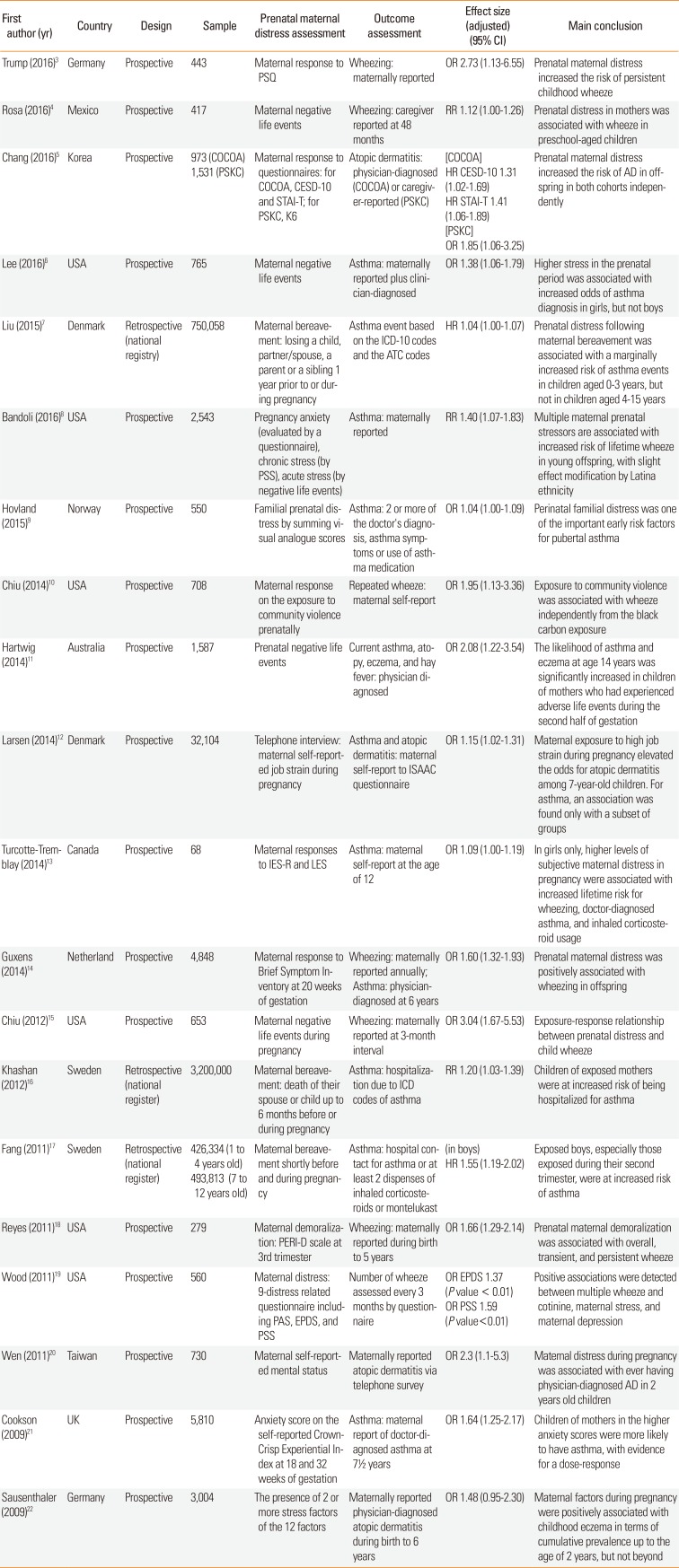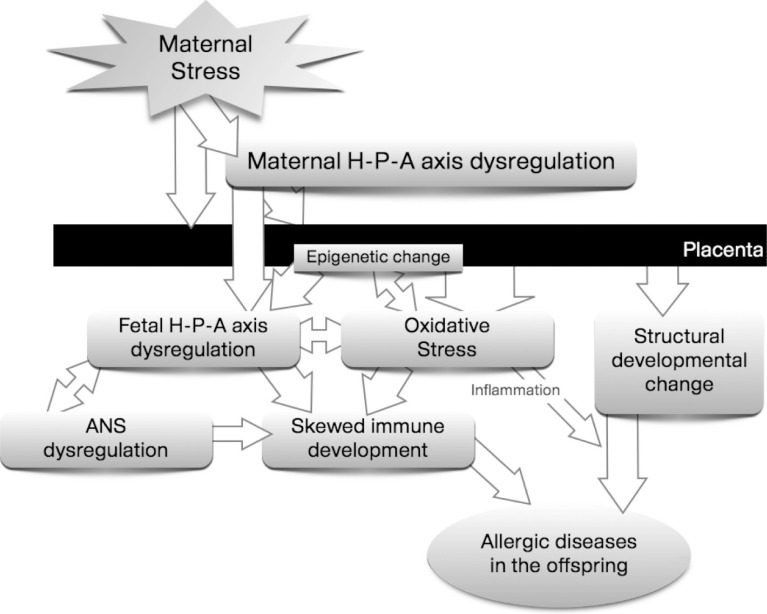Abstract
ACKNOWLEDGMENTS
References
Table
Published cohort or registry studies examining the association between prenatal maternal distress and allergic diseases in offspring

| First author (yr) | Country | Design | Sample | Prenatal maternal distress assessment | Outcome assessment | Effect size (adjusted) (95% CI) | Main conclusion |
|---|---|---|---|---|---|---|---|
| Trump (2016)3 | Germany | Prospective | 443 | Maternal response to PSQ | Wheezing: maternally reported | OR 2.73 (1.13–6.55) | Prenatal maternal distress increased the risk of persistent childhood wheeze |
| Rosa (2016)4 | Mexico | Prospective | 417 | Maternal negative life events | Wheezing: caregiver reported at 48 months | RR 1.12 (1.00–1.26) | Prenatal distress in mothers was associated with wheeze in preschool-aged children |
| Chang (2016)5 | Korea | Prospective |
973 (COCOA) 1,531 (PSKC) |
Maternal response to questionnaires: for COCOA, CESD-10 and STAI-T; for PSKC, K6 | Atopic dermatitis: physician-diagnosed (COCOA) or caregiver-reported (PSKC) |
[COCOA] HR CESD-10 1.31 (1.02–1.69) HR STAI-T 1.41 (1.06–1.89) [PSKC] OR 1.85 (1.06-3.25) |
Prenatal maternal distress increased the risk of AD in off-spring in both cohorts independently |
| Lee (2016)6 | USA | Prospective | 765 | Maternal negative life events | Asthma: maternally reported plus clinician-diagnosed | OR 1.38 (1.06–1.79) | Higher stress in the prenatal period was associated with increased odds of asthma diagnosis in girls, but not boys |
| Liu (2015)7 | Denmark | Retrospective (national registry) | 750,058 | Maternal bereave- ment: losing a child, partner/spouse, a parent or a sibling 1 year prior to or during pregnancy | Asthma event based on the ICD-10 codes and the ATC codes | HR 1.04 (1.00–1.07) | Prenatal distress following maternal bereavement was associated with a marginally increased risk of asthma events in children aged 0-3 years, but not in children aged 4-15 years |
| Bandoli (2016)8 | USA | Prospective | 2,543 | Pregnancy anxiety (evaluated by a questionnaire), chronic stress (by PSS), acute stress (by negative life events) | Asthma: maternally reported | RR 1.40 (1.07–1.83) | Multiple maternal prenatal stressors are associated with increased risk of lifetime wheeze in young offspring, with slight effect modification by Latina ethnicity |
| Hovland (2015)9 | Norway | Prospective | 550 | Familial prenatal distress by summing visual analogue scores | Asthma: 2 or more of the doctor's diagnosis, asthma symptoms or use of asth- ma medication | OR 1.04 (1.00+1.09) | Perinatal familial distress was one of the important early risk factors for pubertal asthma |
| Chiu (2014)10 | USA | Prospective | 708 | Maternal response on the exposure to community violence prenatally | Repeated wheeze: maternal self-report | OR 1.95 (1.13–3.36) | Exposure to community violence was associated with wheeze independently from the black carbon exposure |
| Hartwig (2014)11 | Australia | Prospective | 1,587 | Prenatal negative life events | Current asthma, atopy, eczema, and hay fever: physician diagnosed | OR 2.08 (1.22–3.54) | The likelihood of asthma and eczema at age 14 years was significantly increased in children of mothers who had experienced adverse life events during the second half of gestation |
| Larsen (2014)12 | Denmark | Prospective | 32,104 | Telephone interview: maternal self-reported job strain during pregnancy | Asthma and atopic dermatitis: maternal self-report to ISAAC questionnaire | OR 1.15 (1.02–1.31) | Maternal exposure to high job strain during pregnancy elevated the odds for atopic dermatitis among 7-year-old children. For asthma, an association was found only with a subset of groups |
| Turcotte-Tremblay (2014)13 | Canada | Prospective | 68 | Maternal responses to IES-R and LES | Asthma: maternal self-report at the age of 12 | OR 1.09 (1.00–1.19) | In girls only, higher levels of subjective maternal distress in pregnancy were associated with increased lifetime risk for wheezing, doctor-diagnosed asthma, and inhaled corticosteroid usage |
| Guxens (2014)14 | Netherland | Prospective | 4,848 | Maternal response to Brief Symptom Inventory at 20 weeks of gestation | Wheezing: maternally reported annually; Asthma: physician-diagnosed at 6 years | OR 1.60 (1.32–1.93) | Prenatal maternal distress was positively associated with wheezing in offspring |
| Chiu (2012)15 | USA | Prospective | 653 | Maternal negative life events during pregnancy | Wheezing: maternally reported at 3-month interval | OR 3.04 (1.67–5.53) | Exposure-response relationship between prenatal distress and child wheeze |
| Khashan (2012)16 | Sweden | Retrospective (national register) | 3,200,000 | Maternal bereavement: death of their spouse or child up to 6 months before or during pregnancy | Asthma: hospitalization due to ICD codes of asthma | RR 1.20 (1.03–1.39) | Children of exposed mothers were at increased risk of being hospitalized for asthma |
| Fang (2011)17 | Sweden | Retrospective (national register) |
426,334 (1 to 4 years old) 493,813 (7 to 12 years old) |
Maternal bereavement shortly before and during pregnancy |
Asthma: hospital contact for asthma or at least 2 dispenses of inhaled corticosteroids or montelukast |
(in boys) HR 1.55 (1.19–2.02) |
Exposed boys, especially those exposed during their second trimester, were at increased risk of asthma |
| Reyes (2011)18 | USA | Prospective | 279 | Maternal demoralization: PERI-D scale at 3rd trimester | Wheezing: maternally reported during birth to 5 years | OR 1.66 (1.29–2.14) | Prenatal maternal demoralization was associated with overall, transient, and persistent wheeze |
| Wood (2011)19 | USA | Prospective | 560 | Maternal distress: 9-distress related questionnaire including PAS, EPDS, and PSS | Number of wheeze assessed every 3 months by questionnaire |
OR EPDS 1.37 (P value < 0.01) OR PSS 1.59 (P value<0.01) |
Positive associations were detected between multiple wheeze and cotinine, maternal stress, and maternal depression |
| Wen (2011)20 | Taiwan | Prospective | 730 | Maternal self-reported mental status | Maternally reported atopic dermatitis via telephone survey | OR 2.3 (1.1–5.3) | Maternal distress during pregnancy was associated with ever having physician-diagnosed AD in 2 years old children |
| Cookson (2009)21 | UK | Prospective | 5,810 | Anxiety score on the self-reported Crown-Crisp Experiential Index at 18 and 32 weeks of gestation | Asthma: maternal report of doctor-diagnosed asthma at 7½ years | OR 1.64 (1.25–2.17) | Children of mothers in the higher anxiety scores were more likely to have asthma, with evidence for a dose-response |
| Sausenthaler (2009)22 | Germany | Prospective | 3,004 | The presence of 2 or more stress factors of the 12 factors | Maternally reported physician-diagnosed atopic dermatitis during birth to 6 years | OR 1.48 (0.95–2.30) | Maternal factors during pregnancy were positively associated with childhood eczema in terms of cumulative prevalence up to the age of 2 years, but not beyond |
AD, atopic dermatitis; ATC, Anatomical Therapeutic Chemical Classification; CESD-10, the 10 item Center for Epidemiologic Studies Depression Scale; CI, confidence interval; COCOA, the COhort for Childhood Origin of Asthma and allergic diseases; EPDS, Edinburgh Postnatal Depression Scale; HR, hazard ratio; ICD-10, International Classification of Diseases, Tenth Edition; IES-R, Impact of Event Scale-Revised; ISAAC, International Study of Asthma and Allergies in Childhood; LES, Life Experiences Survey; OR, odds ratio; PAS, Pregnancy Anxiety Scale; PERI-D, psychiatric epidemiology research interview-demoralization, PSKC, Panel Study on Korean Children; PSQ, Perceived Stress Questionnaire; PSS, Perceived Stress Scale; RR, relative risk; STAI-T, State Trait Anxiety Inventory-Trait scale.




 PDF
PDF ePub
ePub Citation
Citation Print
Print



 XML Download
XML Download